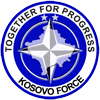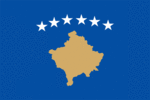

Europe’s newest independent state
Location, political and cultural history
Kosovo is a land-locked country in the Balkans, location shown below-left in relation to other fragments of the former Yugoslavia. There are two official languages, Albanian and Serbian. Hence the dual labelling on the more detailed map below-right. Written Serbian has two forms; it can be set down either in the Latin alphabet or in the Serbian Cyrillic alphabet (Српска ћирилица).
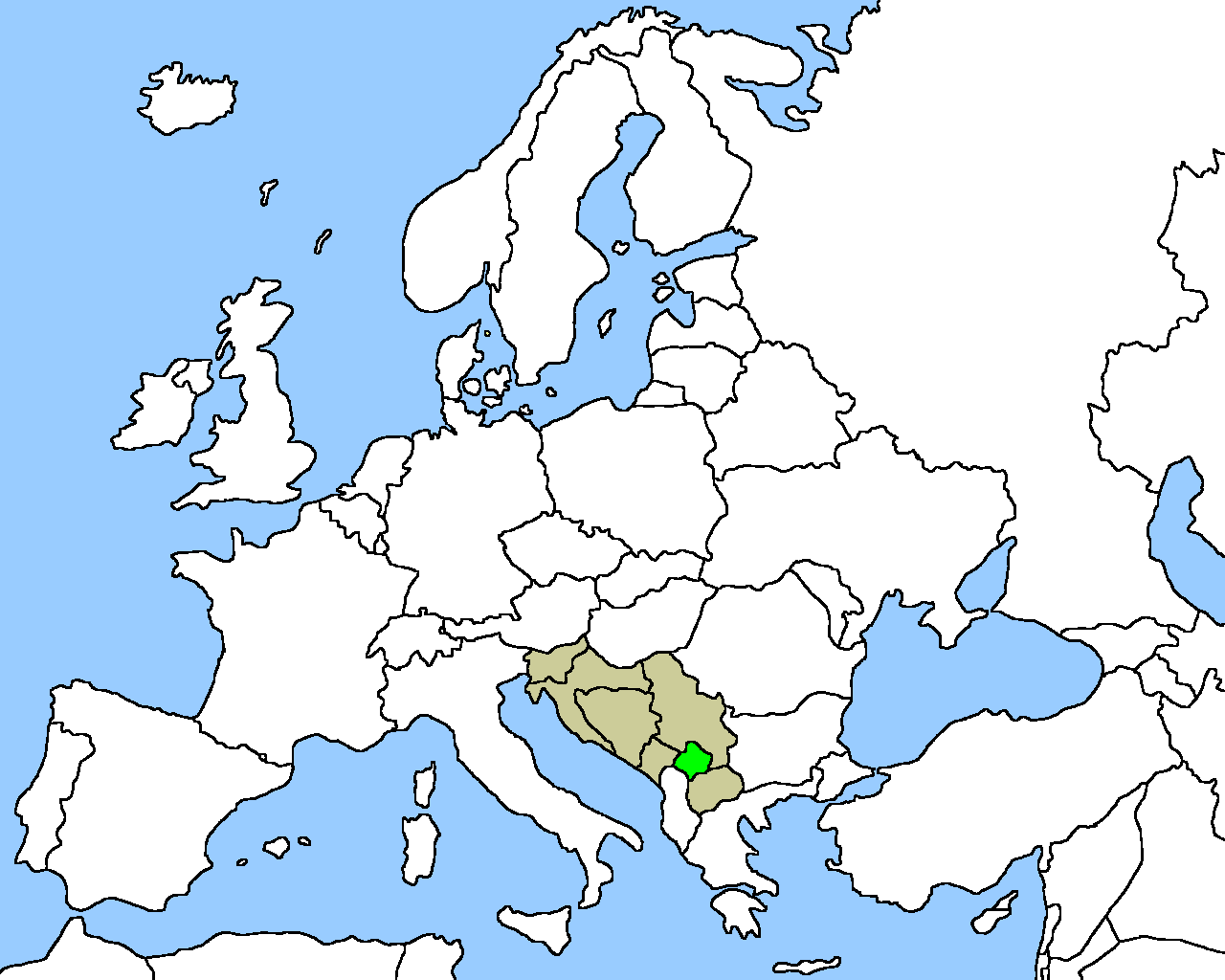 |
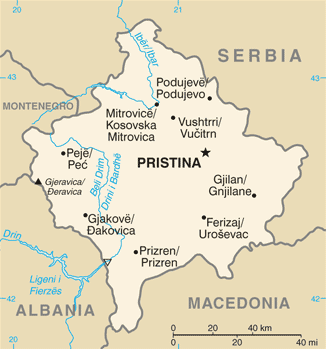 |
| Kosovo in relation to other fragments of the former Socialist Federal Republic of Yugoslavia. To identify the other fragments, please visit our Yugoslavia index page. | The current boundaries of Kosovo itself. |
During classical antiquity, the territory roughly corresponding to present-day Kosovo was inhabited by the Dardani, an obscure tribal group of uncertain origin. Conquered in turn by the Roman, Byzantine, Bulgarian, Serbian and Ottoman Empires, the last of these conquests (in 1389) introduced Islam, and thus religious circumcision, to the population. In 1912, the Ottoman province was divided between Montenegro and Serbia, both of which became part of Yugoslavia when the victor-imposed Treaty of Versailles (28th June 1919, following World War One) created the Kingdom of Serbs, Croats and Slovenes. At that point Kosovo was made a part of Serbia. The kingdom was renamed in 1929 as the Kingdom of Yugoslavia. Occupied in the Second World War initially by Italian forces (1939-43) and then by the Wehrmacht (1943-44), upon liberation by partisans and the Soviet Army the territory that is now Kosovo next became an autonomous province of the Socialist Republic of Serbia under the umbrella constitution of the Socialist Federal Republic of Yugoslavia.
There followed a period of relative stability ‒ the improbable ethnic, cultural and religious mix that was Yugoslavia being somehow held together by the efforts of Marshal Josip Broz Tito. Following Tito’s death in May 1980, the unity of Yugoslavia began to crumble in ways that led to the horrors of the ‘ethnic cleansing’ seen in the Balkans during the 1990s. In 1999, Nato forces ‒ their governments no longer willing to tolerate the activities of the Serbs in Bosnia and Kosovo ‒ launched air strikes against the Serb capital Belgrade. For a short period, all-out war again raged in the Balkans; as a result NATO forces occupied Kosovo.
Thus separated from Serbia, the territory of Kosovo next came under the interim administration of the United Nations Mission in Kosovo (UNMIK). In February 2008, the Assembly of Kosovo declared Kosovo’s independence, recognised (as at 13.Mar.2014) by 107 UN member states. On 8th October 2008, upon request of Serbia, the UN General Assembly adopted a resolution asking the International Court of Justice for an advisory opinion on the issue of Kosovo’s declaration of independence. On 22 July 2010 the ICJ ruled that Kosovo’s unilateral declaration did not violate international law, which its president said contains no “prohibitions on declarations of independence”. On 19 April 2013 Serbia took a first step towards normalising relations with Kosovo when Serbia signed its first agreement with Kosovo as an independent state.
Circumcision in Kosovo in recent times
There can be little doubt that circumcision is an issue that has for years divided the people of Kosovo. The Albanian speakers are mainly Muslim, whilst those speaking Serbian are mainly Eastern Orthodox Christian. During the time that Kosovo was a province of Serbia, circumcision was difficult to obtain - as is evident from the following report transmitted by Radio Free Europe / Radio Liberty on 25 August 1999:
Yugoslavia: Turkish Army Circumcising Muslim Kosovar BoysText © 1999, RFE/RL Inc., All Rights Reserved. Reprinted here in full with the permission of Radio Free Europe/Radio Liberty, 1201 Connecticut Ave., N.W. Washington DC 20036, USA. A link to an archived version of the the original news report appears below, alongside the pre-2005 logo of RFE/RL. Photo © 2001, UNMIK Police.
[Introduction from studio:]
The multinational NATO-led force in Kosovo arrived in the province just over ten weeks ago to establish law and order and democracy in the province. RFE/RL correspondent Jolyon Naegele reports from the southwestern Kosovo town of Dragash that in addition to conducting standard peacekeeping duties, one Turkish KFOR battalion is engaged in circumcising young Muslim boys.
[Report by Jolyon Naegele, located in Dragash:]
The Turkish KFOR battalion in the hill town of Dragash in Kosovo’s Gora region is engaged in the unlikely business of circumcising young Muslim boys between the ages of five and seven.
In the past month, a Turkish KFOR medical team has brought nearly 150 boys in the region -- Muslim Albanians and members of the Muslim Goran minority -- under the knife in sterile conditions. Local parents in Gora and nearby Prizren, home to a sizable Turkish minority, have asked the Turkish Army medical team to circumcise another 300 young boys.
Circumcision, the surgical removal of the foreskin of the penis, is a traditional Muslim practice that in the Balkans and Turkey is performed on young boys in a ceremony preceded by a large family party. Over the weekend, at least two young boys in Prizren dressed up in special circumcision costumes were paraded around town on the roof of their father’s car.
Turkish battalion commander Izzet Cetingoz says the circumcision program constitutes about 10 percent of the total number of local residents whom the Turkish KFOR medical unit has treated so far.
“We have a medical team of a general surgeon under the command of a senior medical officer, a major. We have an ambulance vehicle and a nurse and every day they visit one village and they circumcise boys and the next day they come back, examine the boys and look after the other children too.”
Commander Cetingoz says the medical team also provides emergency medical assistance.
“This is not the regular job of the Turkish Army. Normally we don’t do it in Turkey, but there was a need here requested of us. The children had not been circumcised up to a certain age and unfortunately we have learned that the barbers have been circumcising these boys and they were asking a price of 100 German marks. We know that these people do not have that kind of money. They are poor and we believe that we have done a very important public service.”
Cetingoz says that for the past decade, circumcision was not available as a medical procedure in Kosovo. He notes that traditionally, circumcision is only performed on boys up to the age of five. But since so many Kosovar boys were unable to undergo the procedure in recent years, the Turkish Army medical team has given priority to boys between the ages of five and seven. Once they are done, the Turkish commander says, the team, if called upon, will perform the procedure on younger boys.
The Deutschmark has since ceased to exist as a currency. The Euro equivalent of 100 DM is approximately €51. This sum represented at the time approximately 3% of national per-capita annual income.
Kosovo hamlet clings to tradition with mass circumcision
Article by Ismet Hajdari (© Agence France Presse) ‒ Sunday 28 August 2011.
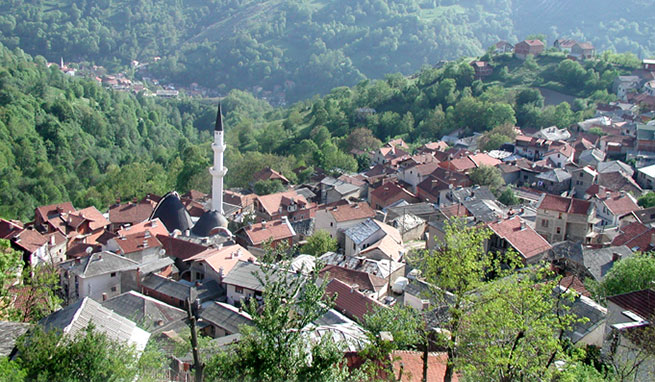
Village of Lubinjë (Ljubinje). Courtesy of info-ks.net.
In a tiny Muslim hamlet deep in the mountains of south Kosovo, the cries of young boys usher in the dawn once every five years in a ritual of mass circumcision to set them on their journey to manhood.
Both a solemn and festive event, a five-man band playing traditional flutes and drums - known as zurla and goc - follow a dozen men led by a local imam and a barber who make their way from house to house in the village of Lubinjë.
Abdil Bajrami, a 90-year-old patriarch, brims with excitement. His two-year-old great-grandson Eldis will be circumcised along with 90 other local boys from 10 months to five years old in a centuries-old ritual known as Sunet.
“Sunet means Eldis is accomplishing two things today: he is starting his life as a man and as a Muslim,” Bajrami told AFP.
The ceremony used to be practiced throughout the area but Lubinje, with its 6,000 residents, is now the only village keeping up the tradition.
“No one knows when it began,” Abdil said.
“I was circumcised in the same way when I was six years old and remember my father and grandfather telling me the same for themselves and their fathers and grandfathers,” he said.
The music stops abruptly and a tense silence sets in as the procession enters Bajrami’s two-storey house on a steep, narrow street.
Only men are allowed to enter the room where the barber, who doubles as local circumciser, readies to perform the brief ritual without anaesthetic.
Women in the family wait anxiously in a side room, notably Eldis’ mother Sheherzada, 28, who falls into a kind of trance performing another age-old tradition, turning a rolling pin quickly and rhythmically between her hands. Local lore holds that this way a mother can remove a son’s pain during the circumcision.
Suddenly a short scream breaks the silence. It is quickly followed by men chanting “Allahu akbar” (God is greater) and “La Ilahah Illa Allah” (There is no God but God), signalling that the young Eldis has gone through the rite, which is obligatory for Muslims.
The music starts up again and the women rush forward to give the honoured visitors the towels tradition demands before the men set off to perform the next circumcision.
Wiping away her tears of joy, Sheherzada enters Eldis’ room, kneeling by his bed and kissing her son’s hand as his father gushes with pride.
“I am the happiest man in the world today,” said 30-year-old Ersan.
“I have lived for this,” he added, then heads out to grill meat for guests packed onto the Bajramis’ huge terrace overlooking the entire village, likewise filled with visitors come to celebrate with the families of the newly circumcised boys.
Lubinje residents call themselves Bosniaks - a term usually used for Bosnian Muslims - though outsiders refer to them as Gorani. They are part of a small Muslim community that settled along the Kosovo boundary with Macedonia, some 120 kilometres (74 miles) south of the capital Pristina.
The Gorani have their own language, a mixture of Albanian, Macedonian, Serbian and Turkish called ‘Nasinski’, which roughly translates as “our language”. And they cling to traditions - rather than politics - to uphold their collective identity in this volatile region with a history of bloodshed.
Sunet remains the prime example, deeply rooted in the soul of the village.
“Sunet is the biggest event in every man’s life,” said Eldis’ 54 year-old grandfather Feim. “You can get married once, twice, as many times as you want, but you can only make Sunet once.”
Locals feel the ritual has helped set them apart from other communities in multi-ethnic Kosovo, where more then 90 percent of 1.73 million inhabitants are Muslim.
“We jealously guard the tradition as it is what makes us recognisable. It is a part of our identity,” a journalist of the local Nasinski-language radio station, Refki Kasi, told AFP.
“Stockholm has the Nobel prize, Hollywood the Oscar and we have the Sunet,” he said, only half in jest.
The mass circumcision kicks off a four-day feast in Lubinje that includes a village lunch, concerts and traditional sports dating back to Ottoman times in the Balkans -- tug-of-war, long jumping, Turkish wrestling and stone-throwing.
As neighbours pass by to congratulate the Bajramis, great-grandfather Abdil greets them proudly.
“Eldis is the 28th boy who was circumcised in the family of 60 members,” he said. “I lived to see four generations of my family taking part in Sunet. It is the biggest fortune in my life.”
and today...
Kosovo has the highest proportion of Muslims of any country in Europe, estimated at 90%. It seems fair to assume that now they are independent a similarly high rate of circumcision will become the norm.
Acknowledgements
The following resources were used in the preparation of this web page:
Wikipedia
NATO Website of KFOR (accessed 25.Sep.2010).
Archive of Radio Free Europe / Radio Liberty (accessed 01.Oct.2010).
Photo archive of the United Nations Mission in Kosovo (UNMIK), Civilian Police division.
Agence France Presse (Quoted by Yahoo Canada, accessed 29.Aug.2011).
Non-governmental body “Kosovo Thanks You” (statistics concerning recognition).
Maps courtesy of www.youreuropemap.com and the US Central Intelligence Agency.
Copyright © 1992 - 2017, All Rights Reserved CIRCLIST.


